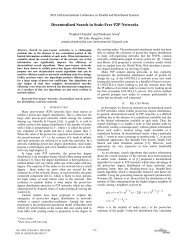Cloud Assisted P2P Media Streaming for Bandwidth Constrained ...
Cloud Assisted P2P Media Streaming for Bandwidth Constrained ...
Cloud Assisted P2P Media Streaming for Bandwidth Constrained ...
You also want an ePaper? Increase the reach of your titles
YUMPU automatically turns print PDFs into web optimized ePapers that Google loves.
cation durations <strong>for</strong> cooperative streaming, hence<strong>for</strong>th<br />
limit peer churns to the minimum and achieve optimal<br />
chunk scheduling. Considering the limited capacity of<br />
some current mobile devices, we assume that peers scan<br />
colocation peers periodically via short-range wireless<br />
network interfaces (e.g., Bluetooth, increasingly being left<br />
switchedon[6]).<br />
The rest of this paper proceeds as follows. We begin by<br />
detailing the background of recent advances in mobile cooperative<br />
streaming (Section II). In Section III, colaborations<br />
among peers are modeled as coalition games, from which<br />
we derive some system design implications. In Section IV,<br />
colocation statistics analysis are presented, be<strong>for</strong>e Section V<br />
summerizes our discussions and sketches our furture plans.<br />
II. BACKGROUND<br />
A. Content Sharing<br />
In [7] by McNamara et al., a media sharing mechanism is<br />
designed to utilize colocation among commuters and renders<br />
it possible to share content with each other in urban transport.<br />
Analyses about how to handle colocation and share content<br />
with peers potentially colocating with each other are conducted.<br />
By selecting peers with the longest average colocation<br />
duration, this mechanism ensures that each peer downloads an<br />
intact file from another peer with higher probability. However,<br />
this paper is restricted to opportunistic communication through<br />
short-range wireless interfaces in urban transport without<br />
Internet connections and colocation duration prediction may<br />
not be satisfiable.<br />
B. Mobile <strong>P2P</strong> <strong>Streaming</strong><br />
A realtime p2p mobile streaming system is proposed in [8]<br />
by Peltotalo et al., demonstrating the feasibility of <strong>P2P</strong><br />
live streaming in mobile networks. Xie et al. [9] illustrate<br />
their open source project of p2p live media streaming <strong>for</strong><br />
handheld devices, and demonstrate the low bandwidth and<br />
limited computation capacity in a handheld device. Akkanen<br />
et al. [10] show the technical feasibility to use portable<br />
devices to actively broadcast media streams. Stiemerling et<br />
al. [2] propose a <strong>P2P</strong>-TV system that enables mobile users to<br />
cooperatively retrieve media chunks in resource constrained<br />
mobile environments.<br />
III. MODELING COOPERATIVE <strong>P2P</strong> STREAMING<br />
In this section, we first propose our system architecture and<br />
<strong>for</strong>mulate cooperative mobile streaming problem, followed by<br />
a coalition game analysis.<br />
A. System Architecture<br />
As depicted in Figure 1, in our system architecture, we<br />
move computation demanding and peer administration tasks<br />
onto clouds, considering the power, bandwidth, computation,<br />
and storage limitations of mobile devices. For example, peers<br />
are assisted with clouds <strong>for</strong> content discovery from content<br />
providers, namely retrieval of content destination in<strong>for</strong>mation,<br />
especially when streaming from an existing <strong>P2P</strong> overlay.<br />
Figure 1.<br />
System Architecture.<br />
<strong>Cloud</strong>s also assist in the <strong>for</strong>mulation of cooperative streaming<br />
via colocation statistics. For clarity, we denote by R(u i ) the<br />
content retrieved by peer u i ,andu i is in the proximity of<br />
u j .IfR(u i )=R(u j ), they may cooperate with each other to<br />
download content and make best use of bandwidth; otherwise,<br />
the one with spare bandwidth can potentially benefact the other<br />
through social ties.<br />
B. Problem Formulation and Local <strong>Streaming</strong> Cooperation<br />
Due to bandwidth scarcity, a single peer with wireless<br />
Internet connections may not possess enough bandwidth to<br />
maintain a satisfactory streaming quality. In reality, colocation<br />
peers may cooperate with each other when they are interested<br />
in the same streaming content or “familiar” with each other<br />
via a built-in social network. There<strong>for</strong>e, content and bandwidth<br />
sharing among peers is desirable <strong>for</strong> the streaming satisfaction<br />
of peers: each peer streams one portion of the media and<br />
exchange them with each other. To obtain a long-term streaming<br />
quality, peers contribute their bandwidth endowments in<br />
a cooperative manner and <strong>for</strong>m a coalition. One peer joins a<br />
coalition only if it obtains extra benefits, otherwise it will keep<br />
out of this coalition. Thus, a coalition game theoretic analysis<br />
is called <strong>for</strong>.<br />
C. Game Formulation<br />
The proposed collaborative streaming problem can be modeled<br />
as a coalition game given by 〈N ,v〉, where function v<br />
associates with every nonempty subset S of N a real number<br />
v(S)—the worth of S—independent with the behavior of the<br />
coalition N/S. Acoalition S is a subset of the entire peer<br />
set N = {0,1,...,|N |}. Peers in a coalition are willing to<br />
cooperate with each other, and herein the worth of S is called<br />
the characteristic function.<br />
Each peer i in the collaborative streaming system cares<br />
about its average power consumption c i and average streaming<br />
rate s i in the period of streaming, both of which are determined<br />
by cooperations among peers and vary w.r.t. S. Denote by Bi<br />
w<br />
bandwidth of its wireless Internet access interface, and Bi<br />
t<br />
bandwidth of its underlying local wireless network interface.<br />
Power constraint is specified as follow: c i ≤ C i , where C i<br />
depends on the specification of i’s power supply; the streaming<br />
constraint is<br />
s i = s ≤ Bi w + Bi t and s i ≤ Bi w + ∑ s ji ,<br />
j∈T<br />
801



